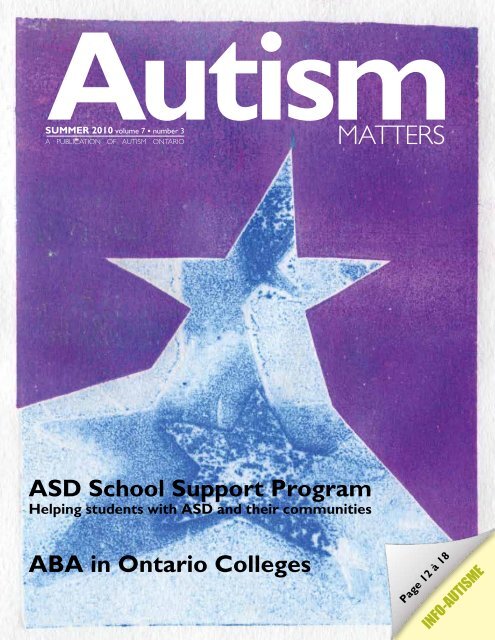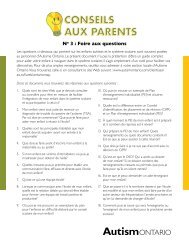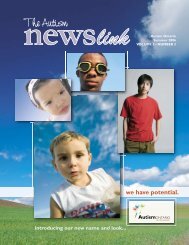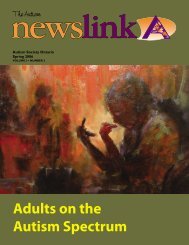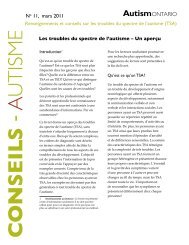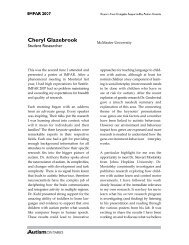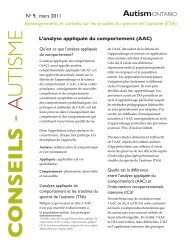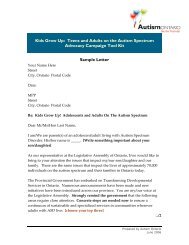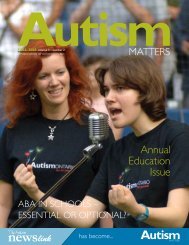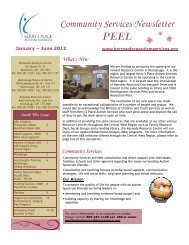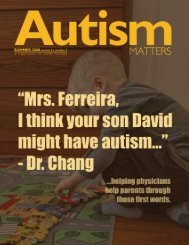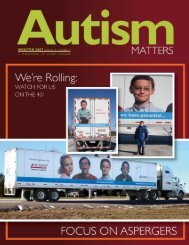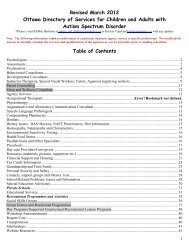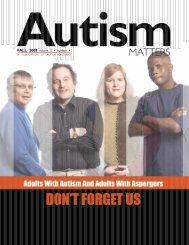AutismMATTERS - Autism Ontario
AutismMATTERS - Autism Ontario
AutismMATTERS - Autism Ontario
- No tags were found...
Create successful ePaper yourself
Turn your PDF publications into a flip-book with our unique Google optimized e-Paper software.
table OF CONTENTSWhat’s InsideOUR SUMMER 2010 ISSUEBoard of DirectorsJane Burke-Robertson, Dr. Cynthia Goldfarb (Treasurer),Muriel Hansen, Jane Houlden, Deborah Kitchen (PastPresident), Gail Laliberte, Eddy Lloyd, Amanda McNulty(Chair of President’s Council), Leah Miltchin (Vice-President),Dr. Jo-Ann Reitzel, Monica Richardson (President), MichaelSpicer (Secretary), Cathy WhiteVolunteer Spotlight –Wayne GriffithsLocal ChaptersTo find contact information for your local <strong>Autism</strong> <strong>Ontario</strong>chapter, visit www.autismontario.com.<strong>Autism</strong> <strong>Ontario</strong>1179A King Street West, Suite 004Toronto, ON M6K 3C5Phone: 416-246-9592Fax: 416-246-9417mail@autismontario.com<strong>Autism</strong> <strong>Ontario</strong> is a registered charitable non-profit organization(#11924 8789 RR0001).OUR VISION: Acceptance and opportunities for all individualswith <strong>Autism</strong> Spectrum Disorders (ASD). Our Mission: Toensure that each individual with ASD is provided the means toachieve quality of life as a respected member of society. <strong>Autism</strong>Matters is published four times per year. <strong>Autism</strong> Matters welcomescontributions from its readers. Send your articles, reviews,letters, comments, announcements, etc., to Margaret Spoelstra,<strong>Autism</strong> Matters Editor. For advertising rates and inquiries contactGEPM Group Inc., info@gepmgroup.com. Inclusions of informationnot directly related to <strong>Autism</strong> <strong>Ontario</strong> are for informationonly and individuals, events, therapies, treatments, etc., are notnecessarily endorsed by <strong>Autism</strong> <strong>Ontario</strong>.features35810Meet our Future – Reaching our Goals TogetherJust Write! by Stephanie Coveart• Move over mom, it’s Jr. JustWriter, by Tracey Coveart• The complex beauty of ASD Shirley, by Tracey CoveartASD School Support Program, by Elizabeth ScottApplied Behaviour Analysis in <strong>Ontario</strong> Colleges, by Sarah Steacie12 Info-<strong>Autism</strong>eAnything is Possible, by Joane Veilleux19212427293131323434coverOur Strategic Plan – Our Story, by Karyn Dumble<strong>Autism</strong> advocate gets A+, by Paul CluffE-mailing an Aspie, by Malcolm MatthewsStages of <strong>Autism</strong>: Adolescence and Beyond, by Linda Beedham, LeeSteel, Howard Weinroth, Todd SimkoverMarch Break Success, by Margaret SpoelstraTogether for <strong>Autism</strong> Event, by James AxiakImproving Health Care Services in <strong>Ontario</strong>, by Marilyn ThompsonStaff Focus – Karyn DumbleIn Your Corner, by Karyn Dumble“Rising Star.” Be inspired by the artwork ofGrace Culletin. Contact details available onp. 33.p. 5book reviews25 House Rules, by Jodi PicoultReviewed by Kathleen Langstroth,Malcolm Matthews, Carolyn McGloin,Erin Corrado and Gail D’ArcyEditing, design and printing services, GEPM Group Inc. • www.gepmgroup.com
early years, it took me some time to realizethat my baby was a rare and precious gift,and that what she could do far outweighedwhat she couldn’t.As another parent of a daughter withspecial needs once said to me, “At leastwe’ll never have to worry about them cominghome on the back of a Harley.”It’s true. But it’s so much more than that.Born into a world that often seems evilThe complex beauty of ASD Shirleyby Tracey Coveart, The Scugog StandardWhen my daughter wasborn almost 19 years ago, autism wasa continent that wasn’t even widely recognized,much less explored.It was in 1943 that Dr. Leo Kanner firstdescribed autism as a unique condition.He believed the cause was cold, unlovingmothers. Fortunately for the moms of autisticchildren everywhere, our understandingof the brain hascome a long wayin the last 50 years.We now know that<strong>Autism</strong> SpectrumDisorder (ASD) is acomplex neurobiological condition that affectsthe normal development of the brainand causes communication problems, impairedsocial interactions, a noticeably restrictedrepertoire of interests and activitiesand a tendency to repeat specific patternsof behaviour. Children with autism are alsomore likely to suffer from other conditions,including developmental delay, epilepsy, Tourette’sand ADD.Although there were countless timeswhen I wanted to wear a T-shirt printedwith the disclaimer “I’m not a bad mother...my daughter is autistic,” I think most peopleare beginning to realize that rather thanlove our children less, mothers with autistickids love them – if possible – even more, orat least more fiercely.The smiling has neverstopped. She is the happiestperson on the planetand despairing and doomed to destruction,Stephie somehow remains good and sweetand pure and faithful and honest. And everytime I look at her smiling face or watch herflap in excitement at the flight of a butterflyor am the lucky recipient of one of her fiercehugs or hear about her plans for a betterworld where no cats are set on fire by teenageboys, she gives me hope and the courageto keep believing. I’ll never forget the day when a headpediatrician at the Children’s Hospital ofEastern <strong>Ontario</strong> sat me down in his officeafter a battery of tests and told me that mydaughter was mentally retarded. It was justanother nail in the coffin of my little girl’s“ordinary” life, but it was still a shock. I’msure he was fired shortly afterwards for hispolitical incorrectness.In addition to beingglobally developmentallydelayed(the new mentallyretarded), Stephiedeveloped a devastatingseizure disorder at 18 months andwas diagnosed with autism at six years ofage, one year before she toilet trained. Shescreamed 23½ hours a day until she learnedto crawl, at which point she started smiling– even when she was having a seizure every10 seconds. The smiling has never stopped.She is the happiest person on the planet(unless there is a change of plans) and shespreads her joy like jam on toast.As a toddler, Stephie focused exclusivelyon animals (she still does – thank you/curseyou Walt Disney for your ever-expandingcatalogue of animated animal films) andlived in “the tiny pink world that mommybought.” She liked to run away, did not wantto be touched, had no fear of anything butgravity, watched TV with her face an inchfeature PERSONAL STORYfrom the screen, made little or no eye contact,could not make sense of the mechanicsof conversation, failed to pick up on socialcues, banged her head for hours at night toput herself to sleep and flapped in excitementlike a crippled bird who might by somemiracle become suddenly airborne.Stephie still bangs, flaps and averts hereyes, but she sticks to me like crazy glueand craves my hugs and kisses. She cannotconsistently spell her own first name but shetalks like a scholar and knows her Disneymovies so well that she has even workedherself into the script and altered the dialogueaccordingly. She can’t find her way toher grandparent’s house around the corner,but she knows the name and breed of everydog we’ve ever met on the street. She can’tride a bike or catch a ball but she’s been involvedwith the Durham Therapeutic RidingAssociation (DTRA) for 14 years and thereis nothing more beautiful than that girl ona the back of a horse, tall and proud andsmiling her dazzling smile. She calls her brain“Shirley” and when she’s having a particularlydim day she just laughs it off and explainsthat Shirley has gone to Cuba for a vacation(often with her shrimp children in tow, whoeverthey are).What we would give to be Shirley justfor a day! To see the world through Stephie’skind eyes. To know what she knows.To love so completely. To live so innocently.To have the capacity to experience pure joyon a daily basis.April [was] National <strong>Autism</strong> AwarenessMonth ...a time for people with an autisticchild to celebrate, ...a time for people whohave never been exposed to the inexplicablegifts of autism to try to understand,and above all to accept. Brains like Shirleyare found in as many as six in every 1,000children and as neuroscientists begin to understandmore about the autistic mind, theyare going to discover complexities of learningthat they never thought possible. Autisticchildren have so much to teach us and I, forone, can’t wait to learn. Stephie and I willtake this journey together and I can’t imaginea better travelling companion. SUMMER 2010 <strong><strong>Autism</strong>MATTERS</strong> 7
feature EDUCATIONASD School Support ProgramHelping students with asd and their communities,by Elizabeth Scott, Vice-President, <strong>Autism</strong> Programs, Surrey Place Centre; Co-Chair, ProvincialAdvisory Team; Collaborative Services Delivery Models for Students with ASDFor the past five years theSchool Support Program – <strong>Autism</strong>Spectrum Disorder (SSP-ASD)has been helping students with<strong>Autism</strong> Spectrum Disorder (ASD)in 72 English and French languagepublicly-funded school boards across<strong>Ontario</strong> by providing enhancededucational services for educators.In 2004 the collaborative efforts of the Ministry of Children and Youth Services(MCYS) and the Ministry of Education (EDU) established the SSP-ASD throughnine regional providers across <strong>Ontario</strong>. Through this program, ASD consultants areconnected with school boards to support educators (e.g., teachers, educational assistants,principals, lunchroom supervisors) in their work with children diagnosed withASD. The SSP-ASD offers professional development opportunities on a variety oftopics related to ASD, assists with identifying, developing and sharing resources, andoffers individual or group consultations to assist educators in their work with identifiedstudents.In addition to successfully supporting its mandate of supporting educators withinthe publicly-funded educational system, the SSP-ASD has also played a significantrole in supporting communities, by effectively delivering training and resources to avariety of community partners such as daycares, parks and recreation, health providers,universities, colleges, police officers, hockey teams and more.8 <strong><strong>Autism</strong>MATTERS</strong> SUMMER 2010
feature EDUCATIONOne such community partner is theGrandravine Special Program, a charitableorganization that runs a hockeyprogram for individuals with variousdevelopmental challenges, most notablyASD. They are called the GrandravineTornadoes and are affiliated with SpecialHockey International. The heart ofthe program is a group of approximately25 volunteer coaches ranging from universitystudents to retired seniors. Thesecoaches all have a hockey background ofsome sort but many have had very limitedexposure to those with special needs.“We approached Surrey Place Centrewho agreed to help our coaches developstrategies that could be used with theplayers to engage them better and to dealwith some of the behaviours that presentthemselves on the ice and in the dressingrooms. They put on an excellent presentationbut the most significant progresswas made during the extensive question/answer session. The back-and-forth dialogueresulted in developing strategiesthat the coaches use today. Surrey PlaceCentre and the School Support Programis a very welcome resource in our “playbook,”and we also respect the individualsupport that they provide to many of themembers of our organization.” – MichaelLiotta, Grandravine Special ProgramOther community training eventscomments“I am writing this letter to express oursincere gratitude for being able to attendthe workshop provided by the SSP-ASD.It was a great opportunity for our staffto learn about autism and apply “wisdom”learned through the session to ourdaily work with parents and children.The SSP-ASD has shared a lot of valuableinformation with us, which will helpus refer the clients to right resources ifproblems arise.” - Language Instruction forNewcomers to Canada (LINC) Coordinator“Thank you so much for coming in.The students’ comments really indicatedto me that my objectives had been met.They have walked away with an indicationof what it must be like to have autismand some strategies for working withsomeone who has autism. I really hopethat you will be able to return again nextyear. Thank you so much.” – Dr. Julie K.Corkett, Assistant Professor of Education,Special Education/Educational Psychology,Nipissing UniversityThe strategies used in trainings andconsultations offered by the SSP-ASDare guided by research and scientificevidence-based methods of intervention,including the fundamental principles ofApplied Behaviour Analysis (ABA). Theprogram has a wealth of existing trainingmaterials in both English and French tobuild community capacity.The Connections for Studentsmodel, developed in 2009 by EDU andMCYS to support the transition from IntensiveBehaviour Intervention to school,has proven successful by increasing collaborationamong SSP-ASD, SchoolBoards and AIP providers and supportingthe incorporation of ABA strategieswithin each child’s Individual EducationPlan (IEP) .Preliminary results indicate thatConnections for Students has achievedclear and understandable transition planningwhich reduces parent and studentanxiety, and clear guidelines and expectationsfor parental involvement.The current scope of the SSP-ASDis significant and includes 200+ ASD consultants,supervisors, and support staff;www.speechtherapycentres.com905.886.5941provision of training and consultationsupports for 72 publicly-funded boards,school authorities and provincial schools;in both English and French languages;encompassing 4,011 elementary and892 secondary schools; 118,000 educatorsand 7,300 administrators; 2,104,102students; and 12,752 identified studentswith an ASD.The program has 175 expert ASDconsultants who are specialists in autismand ABA. The SSP-ASD has providedservices to 407,652 participants through47,982 consultations and 18,482 trainingevents, and distributed 1,346,672 resourcesduring the past three years alone.Many of the SSP-ASD programs usea coaching model of consultation whichinvolves providing individualized followupmodelling and coaching for participantsafter they attend a training event.The SSP-ASD has also applied thismodel and supports to community serviceproviders. A team-based approachto meeting the needs of children withASD and individualized support is effective.With its track record of success,the expertise across the province in theSSP-ASD can continue to provide directsupport to individuals, and help to bettermeet the needs of children with ASD andtheir communities. TSTCC_<strong>Autism</strong> Matters ad:<strong>Autism</strong> Ad 4/12/10 1:00 PM Page 2• Diagnostic and therapeutic servicesfor individuals and their families• Qualified team of registeredspeech-language pathologists• 1:1 and group therapy for children,adolescents and adults• Social Communication Groupsand Parent Workshops• No waiting lists• Saturday appointments available• Locations conveniently locatedacross the GTASUMMER 2010 <strong><strong>Autism</strong>MATTERS</strong> 9
feature EDUCATIONApplied Behaviour Analysis in<strong>Ontario</strong> CollegesAs a Psychology student in university, I alwayswondered where I would end up.by Sarah SteacieI knew I was interested in thefield of autism, but I had no idea what wasout there in terms of work, other thanresearch, of course. By the end of myfourth year I began to worry about whatI would do with my life. Would I evenget a job? Did I have enough experience?I began thinking about college; perhapsthere was a course out there that wouldgive me some of the hands-on experienceI was looking for to increase my confidencebefore entering the workforce.I searched through the <strong>Ontario</strong>Colleges website and stumbled across apost-graduate college program. I didn’teven know those existed. Through furtherexploration I found a program called<strong>Autism</strong> and Behavioural Science – a programfor students who had graduatedfrom college or university and were lookingto further their education in the field.I thought this sounded great, so I appliedto a few programs across the province.I continued looking and found somethingeven more perfect for me. BehaviouralSciences Technology, a programoffered only at St. Lawrence College andGeorge Brown College. This particularpost-graduate program is offered specificallyto university graduates with adegree in Psychology, in a one-year intensiveformat. I felt like everything I hadbeen asking for had just been answered.I applied, and was accepted at GeorgeBrown College in Toronto.Within <strong>Ontario</strong> there are four undergraduateprograms that focus on the10 <strong><strong>Autism</strong>MATTERS</strong> SUMMER 2010principles of Applied Behaviour Analysis.These programs are <strong>Autism</strong> and BehaviouralScience, Behavioural ScienceTechnology (three-year program), BehaviouralScience Technology (one-yearintensive, post-graduate), and BehaviouralPsychology (degree program).<strong>Autism</strong> and Behavioural Science(ABS) is offered at colleges all over theprovince and is designed to provide studentswith the opportunity to acquire thenecessary skills to work with childrenwith autism as Instructor Therapists inan Intensive Behavioural Intervention(IBI) setting. The program is one year(two semesters), which includes coursework focusing on working with childrenwith <strong>Autism</strong> Spectrum Disorder, andtwo field placements in settings relatedto ABA and autism. Courses include anIntroduction to both <strong>Autism</strong> and AppliedBehaviour Analysis, Treating ChallengingBehaviour, Transition Planning andImplementation, as well as a certificationopportunity in Non-Violent Crisis Preventionand Intervention. This programwas developed to create more qualifiedand highly skilled individuals able towork in the many agencies providing servicesfor children with autism. Studentsenrolled in the program earn an <strong>Ontario</strong>Graduate Certificate upon completion ofprogram requirements.The three-year program in BehaviouralScience Technology is offered atSt. Lawrence and George Brown Collegesonly. This program gives students thechance to learn about Applied BehaviourAnalysis in an applied setting. Studentsin this program must have a high schooldiploma before beginning the program.With five field placements, students areSarah Steacie with her Practicum Poster, at George Brown College’s Behavioural Science TechnologyAnnual Open House and Poster Session on April 23, 2010.Photo credit: M. Spoelstra
able to gain a wide variety of experiencesinvolving working with different populations(autism, acquired brain injury, dualdiagnosis, etc.) as well as working in differentsettings (IBI, school, consultation).Courses begin at the basic level and advanceas the student progresses throughthe program. Some of the courses offeredin the program include an introductionto both Applied Behaviour Analysisand Psychology, Abnormal Psychology,Pharmacology and Physiology, AdvancedIssues in Behavioural Science, and OrganizationalBehaviour. Students in theprogram also have the opportunity toearn certifications for Crisis Preventionand Intervention, and First Aid andCPR. Students in the Behavioural ScienceTechnology program are awardedan <strong>Ontario</strong> College Advanced Diplomaupon completion of program requirements.The one year, intensive delivery ofthe Behavioural Science TechnologyProgram is offered at both St. LawrenceCollege and George Brown College.Students in this program have a three- orfour-year university degree with a majorin Psychology. This program allowsstudents to further their education andapply their knowledge to the field of AppliedBehaviour Analysis. Due to theirbackground in Psychology, students inthe intensive program begin at a moreadvanced level and are able to graduatein the 10-month, three-semester deliveryof the program. Students are introducedto the basics of Applied BehaviourAnalysis in a one-week course beginningin August. After that, students advanceto upper year courses such as Group BehaviourTherapy, Mediator Training,Cognitive Therapy, Mental Health andAddictions, as well as a one-day PharmacologyWorkshop. Students are alsogiven the chance to earn certification inCrisis Prevention and Intervention, andFirst Aid and CPR. Three Field Placementsgive students a chance to see varioussettings in which they have expressedinterest. Once students have completedall program requirements, they areawarded an <strong>Ontario</strong> College AdvancedDiploma.The Behavioural Psychology degreeprogram is exclusive to St. LawrenceCollege. This program accepts studentswith a minimum of a high school diplomaand runs for four years. Studentsbecome acquainted with Applied BehaviourAnalysis at the basic level and thenadvance as they complete the program.The program is made-up of a combinationof course work and field work withWith the increasing need forskilled service providers forpeople with autism and otherdevelopmental disabilities,colleges are stepping up andoffering programs that canhelp.placements at various community agencies.With 1,100 hours of supervisedfield placement, students acquire a widerange of experiences working with differentpopulations and within a varietyof settings. Some of the courses offeredthrough the Behavioural Psychologyprogram are Negotiation and Mediation,Developmental Psychology, BehaviouralApproaches to Childhood and AdolescentDisorders, Personality Theory andSocial Learning, and Behavioural Approachesto Corrections. Students alsohave the opportunity to earn certificationin Non-Violent Crisis Prevention/Intervention.Upon completing all course requirements,students receive a Bachelorof Applied Arts Degree in BehaviouralPsychology.With the increasing need for skilledservice providers for people with autismand other developmental disabilities, collegesare stepping up and offering programsthat can help. “Most importantly,”says Andrew McNamara, a Professor inthe Behavioural Psychology programat St. Lawrence College, “families andproviders of behavioural services to amultitude of clinical populations nowhave a pool of well-trained techniciansfeature EDUCATIONand therapists to draw upon.” This allowsfamilies and individuals with autismto have access to therapy conductedby highly skilled and experienced staff,providing therapy in a well-establishedbehaviour change approach. Throughthese programs, future service providerscan access important information, gainfield experience, and expand and developtheir education. “The College programs(graduate certificate, diploma and degree)offer the student the opportunityto learn the theory and application ofan applied behavioural science. The keyadvantage of the college approach is theintense field placements that the studentsare required to complete,” says McNamara.Having this hands-on experiencegives students and graduates greater confidencewhen applying for jobs and letsthe employer know they are capable andwell versed in the field.Students graduating from these programsare eligible for a variety of jobs ina number of different areas involving AppliedBehaviour Analysis. Students with agraduate certificate in <strong>Autism</strong> and BehaviouralScience can find jobs as instructortherapistsin private and public-sectoragencies that offer IBI, schools, and privatefamily settings with opportunityfor advancement. Behavioural ScienceTechnology graduates of both the threeyearand one-year intensive programsfind employment with individuals of allages, from a variety of populations, whohave difficult and challenging behaviours.They work to design and implement behaviourprograms and interventions andare able to work in a variety of settingssuch as schools, hospitals, residential andtreatment facilities and rehabilitationand vocational agencies. Graduates ofthe four-year degree program can workin a number of careers, such as addictionscounsellors, instructor-therapists, mentalhealth counsellors and job coaches,as well as some jobs within CorrectionalServices Canada.And here I am, wondering where Iwill end up because now I have too manyoptions! SUMMER 2010 <strong><strong>Autism</strong>MATTERS</strong> 11
info-autismeMarie-Claude Flibotte, M.S.S., T.S.I., coordonnatricedu programme francophone « Réalisonsle potentiel de la communauté » dans lasection d’OttawaMulti-spectacle TSAMarie-Claude est travailleuse socialeprofessionnelle cumulant une vingtained’années d’expérience dans le milieu descentres communautaires. Elle est arrivée àOttawa il y a neuf ans. Son travail avec lacommunauté d’Orléans comme clinicienneet comme agente de développement communautairelui a permis de développer uneconnaissance variée et approfondie des ressourcesdisponibles à Ottawa. Plus récemment,son implication dans l’implantation deMeilleur Départ pour la région est d’Ottawaet pour la communauté francophone enparticulier ainsi qu’un court contrat dans uneécole secondaire l’ont ramenée au travailspécifique avec les familles. Interpellée parles besoins des familles avec un enfant ou unjeune ayant un TSA, Marie-Claude est fièrede se joindre à nous pour contribuer à notremission.Bienvenue Marie-Claude! Le 19 avril dernier, sous la présidence honoraire de M. Georges Orfali, présidentdu CEPEO (Conseil des écoles publiques de l’est de l’<strong>Ontario</strong>), nous avonsassisté à un spectacle formidable des élèves sur le spectre de l’autisme du CEPEOau niveau primaire et secondaire, ainsi que de la classe TSA (troubles sur le spectrede l’autisme) et des élèves de 11 e année en concentration des arts de la scène del’École secondaire publique DeLaSalle à Ottawa. C’est une première, et quel résultatexceptionnel ! Quelle soirée ! Nous avons découvert des talents insoupçonnés chezles élèves… Il y a une très belle relève de danseurs, de comédiens, de musiciens,d’humoristes et de clowns…Ce spectacle symbolise l’union et la force que sont le monde pédagogique, artistiqueet l’enfance en difficulté.Comme madame Suzanne Murphy l’a si bien exprimé, qui aurait dit, il y aquelques années, qu’une telle initiative serait possible? Et bien oui, le Comité organisateurl’a rendue possible. Ce Comité était composé d’Éric Beevis, Luce Marquis,Carole Myre, Nicole Blundell (artiste invitée), Annie Gagné, Jean-Baptiste Arhanchiague,<strong>Autism</strong>e <strong>Ontario</strong>, la Société franco-ontarienne de l’autisme et Vlatko Dabic,enseignant-ressource pour la classe TSA., qui a fait un travail absolument magnifique.Cela fut une expérience inoubliable. Les élèves ont vraiment donné le meilleurd’eux-mêmes.De plus, les élèves de la classe TSA avaient fait des œuvres magnifiques en artvisuel qui sont maintenant en exposition dans diverses écoles du Conseil.En espérant qu’on aura encore la chance de voir un spectacle dans lequel noschers enfants autistes pourront pleinement se réaliser et collaborer activement avecdes élèves neurotypiques.Une maman très fière.Marie Lemaire12 <strong><strong>Autism</strong>MATTERS</strong> ÉTÉ 2010
info-autismeColloque présenté parl’organisme « Parents pour lasanté mentale des enfants »par Chantal DurlingMe voici, après ma quatrième annéede participation à la conférence del’organisme « Parents pour la santé mentaledes enfants » (Parents for Children’sMental Health-PCMH), à vous partagermes idées face à ce dossier qui me passionnequotidiennement. Le tout s’estprésenté lorsque Les services à l’enfance età la famille de Timmins et du district m’ontabordée afin de considérer la possibilitéd’entreprendre et de gérer un groupede soutien dans notre communauté.Évidemment, je me devais de bien évaluerma position et mon rôle dans cettesituation car, comme vous, le temps memanque parfois. Ceci dit, j’ai vite concluque c’était un projet qui m’intéressaitbeaucoup et qui était, sans doute, unenécessité dans notre communauté. Grâceà PCMH, j’ai développé davantage mesconnaissances en enfance en difficulté,que j’ai, en retour, réussi à partager avecles familles de notre région.L’autisme est un trouble du développementqui affecte la capacité d’unepersonne à communiquer, à développerdes relations avec les autres et à répondrede manière appropriée aux stimuli de sonenvironnement. Le mot « autisme » estaujourd’hui souvent synonyme de ce queles médecins appellent les « troubles envahissantsdu développement » (TED).Les personnes ayant un TED ont unensemble de symptômes spécifiques affectanttrois domaines différents : lacommunication, les rapports sociaux(l’interaction avec les autres) et le comportement.Les TED regroupent unensemble de cinq diagnostics acceptésofficiellement :• L’autisme• Le syndrome d’Asperger• Le trouble envahissant du développementnon spécifié• Le syndrome de Rett• Le trouble désintégratif de l’enfanceUn enfant sur 125 se retrouve sur lespectre de l’autisme.De plus, les statistiques indiquentqu’un enfant sur cinq souffre d’un troublemental. Toutefois, soixante pour centde cette population ne recevra pas lesservices nécessaires à son rétablissement.Suite à cette réalisation, le groupe à butnon lucratif PCMH, géré par des parentspour les parents, a donné une voixet une reconnaissance aux familles ayantdes enfants ou des adolescents souffrantde troubles mentaux. L’organisme offredu soutien et renseigne les familles au sujetdes agences et des services disponiblesdans leur communauté.Récemment, j’ai profité d’une formationdirigée par Sarah Cannon, directricede PCMH, Arlene Pearly Rae etKevin Flynn, le député d’Oakville. Cecim’a permis d’approfondir mes connaissancesainsi que de m’outiller afin debien desservir les familles dans ma communauté.De plus, j’ai participé à deuxformations traitant de la survie chez nosadolescents, par Tony Antidormi, del’agence Services à l’enfance de Niagara.Les thèmes étaient les suivants :• Amélioration des relations• Quand contacter un professionnel• La norme chez les adolescents• Les changements hormonaux chez lapopulation autiste• La pression des pairsÉTÉ 2010 <strong><strong>Autism</strong>MATTERS</strong> 13
info-autismeDieu merci ! Les autistes sont làConférence animée parStephan Blackburn• Stratégies pour améliorer la communicationentre parents et adolescents.La deuxième formation était « Wellnessand Self Care For Guardians »,présentée par Reem Abdul Quadir, untravailleur social qui travaille commethérapeute familial et consultant canadienet international. La session ciblaitles parents d’un enfant ayant des besoinsparticuliers. Aussi, des stratégies de gestionde stress nous ont été présentées.Avoir une conscience de soi est nécessairepour notre santé et bien-être. Lesparents d’un enfant avec des besoinsparticuliers ressentent trois fois le stressd’un autre parent. Les aspects les plusimportants sont le repos, la nutrition,l’exercice et le temps seul ou entre amis,même s’il ne s’agit que de 15 minutespour se recentrer. Les parents de ces enfantsse doivent d’être très impliqués. Ledéfi de s’assurer qu’une programmationscolaire est adéquate pour leur enfant,que le côté social et affectif sont bienrejoints et que la communication entrele foyer et l’école est faite de façon régulièreet professionnelle, peut être trèsépuisant. De ce fait, s’affilier à un groupede soutien, partager notre vécu dans lebut d’aider une autre famille, et se faireentendre et comprendre, sont primordiauxdans la vie de l’enfance en difficulté.Nous sommes prêts à vous accueillir àbras et à cœur ouverts ! par Nacéra ZitounLa conférence de Stephan Blackburn intitulée « Dieu merci ! Les autistes sontlà » a eu lieu le 8 avril 2010 à l’UQO (Université du Québec en Outaouais). Il y avaitbeaucoup de participants, des parents, jeunes autistes, enseignants et organisateursde la conférence et la salle était bien remplie ce soir-là. Il faut dire qu’on avait hâted’entendre Stephan, philosophe, pédagogue et musicien qui est lui-même autiste. Enfait, il a été diagnostiqué du syndrome Asperger à l’âge de quarante ans; marié et pèrede deux enfants autistes, l’ainé, François, est également diagnostiqué du syndromed’Asperger et le petit Olivier est autiste du type Kanner.La conférence était enrichissante et bien informative. Stephan connait bienl’autisme et on apprend vraiment avec lui. Il nous confie avec beaucoup d’humour etde simplicité son point de vue sur ce sujet qui le passionne notamment sur l’apparitionmassive des autistes et sur leur façon d’apprendre.Il déclare que contrairement à la pensée populaire, il n’y a pas plus d’autistesqu’auparavant. Il ajoute même que les autistes ont toujours été présents dans l’histoirede l’humanité et que c’est seulement maintenant qu’ils ont été mis de côté et sont considéréscomme handicapés. Il cite d’ailleurs quelques exemples de personnes autistesqui ont contribué par leur travail, recherches, découvertes ou autres et ont changé lemonde tels que, Spinoza, Socrate, Mozart, Ludwig Van Beethoven, Isaac Newton,Van Gogh, Albert Einstein, Glenn Gould ou Bill Gates, et d’autres encore.Stephan mentionne également que l’autisme n’est pas un trouble ou un handicapmais c’est juste une autre façon de voir le monde. Ainsi, il explique que la personneautiste voit le monde différemment, d’une manière plus directe et sans nuance et perçoitdonc son environnement autrement!Il attire notre attention sur la façon d’agir avec les autistes en précisant que moinsla personne autiste est atteinte plus elle souffre. Comme dans le cas des personnesAsperger ou hautement fonctionnelles qui souffrent plus, malgré leurs forces et leurintelligence parce que leur autisme est moins apparent et elles se sentent alors incomprises.Il explique que la société actuelle est très compétitive et exige par exemple auxemployés d’être multifonctionnels, ce qui est probablement difficile à atteindre pourles personnes Asperger ou hautement fonctionnelles même si elles excellent dans certainsdomaines!Il attire notre attention sur la façon d’agir avec les autistes en précisant que moinsla personne autiste est atteinte plus elle souffre. Le conférencier nous fait remarquerque l’enfant autiste qui est dans sa bulle ou son monde est aussi intelligent qu’un neurotypique;la seule différence réside dans la manière d’enregistrer des informations.C’est-à-dire que le neurotypique ou la « personne normale » est capable de gérer14 <strong><strong>Autism</strong>MATTERS</strong> ÉTÉ 2010
info-autismeplusieurs informations en même temps alors qu’une personne autiste a une intelligenceplus ciblée, plus orientée. Il compare cette dernière à un laser ou projecteurqui éclaire avec une forte lumière dirigée vers un angle plus ou moins grand. C’est laraison pour laquelle, d’après lui, les autistes sont excellents dans certains domaines etne le sont pas dans d’autres. La vie de « chacun pour soi » n’aide malheureusementpas les autistes.Le défi des enseignants ou intervenants sera donc de découvrir l’étroite ouverturepar laquelle passe justement cette forte lumière afin de trouver le génie de cetenfant et l’aider à apprendre pour qu’il soit plus heureux dans cette vie compétitive.Note de l’éditeur : Stephan Blackburn fait référence aux « autistes » mais nous reconnaissonsque plusieurs familles ont recours à l’expression « les personnes autistes ». Gestion de l’anxiété chez lespersonnes TED/DIpar Marie-Claude FlibottePar une belle journée ensoleillée en mai dernier, une quarantaine de personnesse sont réunies pour s’outiller afin de désamorcer l’anxiété qui assaille souventles enfants et les jeunes sur le spectre de l’autisme que nous côtoyons au quotidien.D re Marie-Hélène Prud’homme, psychologue et Julie Deschatelets, consultanteen psychologie, se sont relayées pour faire le point avec nous sur l’anxiété, en circonscrirela spécificité chez les jeunes qui nous intéressent, nous aider à l’évaluer et enfinà intervenir pour en faciliter la gestion.D re Prud’homme a œuvré comme enseignante dans un premier temps et elle acomplété des études doctorales en psychologie avant de devenir clinicienne en privéaussi bien que chercheure et enseignante à l’université. Madame Deschatelets est àcompléter son doctorat avec D re Prud’homme et elle est la mère d’un enfant sur lespectre.Nos conférencières nous ont laissés avec des repères simples sur l’anxiété :« l’anxiété, c’est souvent une mauvaise compréhension de ce qui se passe »; l’anxiétése distingue du stress en ce que « tu restes pris avec même après que l’agent stressantsoit passé ». Il y a un spectre de l’anxiété qui affecte les fonctions du corps et del’esprit, entre autres : la respiration et les battements cardiaques, la température ducorps, l’équilibre, l’humeur, la capacité de s’exprimer, et le sommeil.Au moment de l’évaluation, lorsqu’on confirme la présence des symptômesd’anxiété, il est important de se rappeler d’éliminer les possibilités d’un débalancementphysique : par exemple un trouble de la thyroïde peut présenter des symptômessimilaires à l’anxiété.Les individus TED ou avec une déficience intellectuelle (DI) sont plus vulnérablesà l’anxiété et celle-ci aura un impact sur les déficits associés : la communication,les habiletés sociales, les aspects sensoriels, les facteurs physiologiques, lesfonctions exécutives, les comportements inadéquats et la cognition; ainsi que sur lescompétences d’adaptation.D re Marie-Hélène Prud’hommeJulie DeschateletsÉTÉ 2010 <strong><strong>Autism</strong>MATTERS</strong> 15
info-autisme16 <strong><strong>Autism</strong>MATTERS</strong> ÉTÉ 2010L’évaluation informelle passe parl’analyse en fonction de chacun des déficitsliés au trouble. En fait, en changeantl’interprétation qu’on fait des causes descomportements inadéquats, on changeral’orientation de notre intervention: sielles sont associées à l’anxiété, nos interventionsseront plus positives et ellestendront à diminuer le stress tandis quesi elles sont perçues comme un manquede volonté ou un manque d’auto contrôlechez l’individu, nos interventions serontplus punitives.Pour l’évaluation formelle, nousnous sommes familiarisés avec l’outildéveloppé par Gordon et al en 1999 :l’Inventaire du stress pour les individusatteints d’autisme ou de troubles envahissantsdu développement. C’est unoutil flexible qui peut être complété parles intervenants lorsqu’il est questiond’évaluer des enfants à partir de trois etquatre ans et par les enfants eux-mêmesentre sept et neuf ans selon le niveau delangage. Bien entendu, l’utilisation d’unappui visuel facilite l’implication desjeunes dans le processus. De plus, le faitde partir de l’intérêt de l’individu pourdévelopper un outil d’auto-évaluationcontribuera grandement au succès.Au moment d’intervenir pour enseignerà gérer l’anxiété, il est importantde s’assurer que l’enfant ou le jeune estcalme et que nous avons établi des priorités.La désensibilisation à un élémentanxiogène demande un minimum detrois mois.Pour favoriser la relaxation, penserà aménager un espace spécifique qui nes’associe pas à quelque chose de négatifcomme la punition par exemple; donneraccès à du matériel réconfortant; enseignerà la personne à demander une pauseen utilisant un appui comme le billet depause ou autre (NB on pourra ajouter unemarche à suivre à l’endos du billet au besoin).Selon l’individu et les circonstances,il faudra explorer les types de soutienà la relaxation comme la respiration, lesmandalas, la création d’un journal de relaxationpersonnalisé, le yoga, l’échelleà cinq points, le thermomètre d’anxiétéavec les solutions associées à chaqueniveau. Dans les cas de communicationnon verbale, il est possible d’utiliser despoints de couleurs pour identifier les sensationsphysiques créées par l’anxiété surun dessin du corps.À l’aide de multiples exemples selonla tranche d’âges, nous avons approfondil’utilisation et la création d’outils poursoutenir l’identification des pensées intrusiveset les gérer : diagrammes variés,p. ex. pensées négatives – sensation /sentiment – pensée antidote; l’utilisationd’une carte imagée pour apprivoiser unnouvel endroit; l’horaire visuel incluantla transition vers une autre activité, etc.Nous avons fait de même pour faciliterla compréhension des émotions : unlivre des plaisirs / talents / fiertés; un dictionnairedes émotions; une activité dedétective d’émotions; un avis de changementde routine; les scénarios sociaux;les conversations en bandes dessinées,etc. Encore une fois, il est possible deprocéder par écrit aussi bien qu’en images.Nos deux conférencières sont disponiblespour offrir d’autres ateliers enfrançais en <strong>Ontario</strong>. Elles animent entreautres des groupes de jeux sur les activitésde la vie quotidienne.Voici quelques commentaires laisséspar les participants :« Cet atelier était fort apprécié car ilétait très pratique ».« J’adore lorsqu’on donne des exemplesde situations concrètes ».« Je vais, sans aucun doute, me servirdes grilles de l’inventaire du stress ».« La partie sur l’intervention étaitexcellente ». Nouveauté !L’université de Toronto cherche des personnespour participer à une brève étude –Le syndrome d’Asperger ou l’autisme de hautniveau : une étude translinguistique. Veuillezvisiter pour plus d’information.Comment on le dit enfrançais?De plus en plus, on nous demande la terminologiefrançaise pour divers termes utilisésdans le domaine de l’autisme. Souvent, dansles contextes français, les termes anglaissont utilisés parce que les gens ne connaissentpas la terminologie française. De plus,il existe souvent plus d’une traduction pourle même terme. Afin d’assurer que le publicfrancophone soit informé, nous présenteronsun terme anglais, sa traduction en françaisainsi qu’une définition.GlossaireErratumVeuillez noter une correction pour unedes traductions de « Applied BehaviourAnalysis ». L’acronyme pour l’analyse appliquéedu comportement est AAC.Terme en anglais : Picture Exchange CommunicationSystem (PECS)En français : Système de communication paréchange d’images (PECS)Définition : Le système de communicationpar échange d’images est un systèmede communication fonctionnelle créé par leD r Andrew Bondy et l’orthophoniste LoriFrost. Ce système de suppléance à la communicationconçu à l’origine pour les enfantsautistes non verbaux est maintenant utiliséavec des individus d’âges variés présentanttoutes sortes de troubles de communication.L’acronyme PECS est accepté en français.Pour de plus amples renseignements,veuillez visiter www.pecs.com.
info-autisme« Tout est possible ! »Atelier présenté par la dynamique Paula Kluthsur les problèmes de comportementspar Joane Veilleux, coordonnatrice desservices en français du programme« Réalisons le potentiel de lacommunauté » d’<strong>Autism</strong>e <strong>Ontario</strong>Joane VeilleuxPaula Kluth possède plusieurs cordes à son arc : consultante, enseignante,auteure, intervenante et chercheure-boursière indépendante. Sa passion principaleconsiste à créer les meilleures conditions possibles pour les élèves ayant des besoinsparticuliers. J’ai assisté à sa présentation sur les problèmes de comportement à Durham,le 25 mai dernier. Dès le départ, elle invite les participants à décrire des situationsqui les ont embarrassés ou mis mal à l’aise, et à évoquer un comportement dontils ne sont pas très fiers et qu’ils préféreraient oublier. D’emblée, la salle s’anime!Tout le monde se lance à la recherche d’exemples. Une personne s’est emportée contreun conducteur de tramway, une autre contre son mari, et la liste s’allonge!Il est intéressant de constater que lorsque nous sommes confrontés à nos propresluttes, nous pouvons plus aisément nous mettre à la place des autres, notamment,celle d’un enfant. Au lieu de penser que cet enfant est méchant ou effronté, nous devenonsplus empathiques. Si j’ai déjà perdu la maîtrise de moi-même, j’accepte mieuxque les autres succombent eux aussi à leur humeur passagère.Comment revenir à notre « état normal »? À quelles stratégies faire appel pournous calmer? Paula nous propose une liste d’idées dans laquelle puiser et je lui suisreconnaissante de me les rappeler (je me sens tout à coup plus calme!) : prendre consciencede sa respiration, écrire dans un journal personnel, s’éloigner de la situationproblématique, rire, prendre un bain, écouter le son des vagues, recevoir une marqued’affection d’une personne qui nous est chère, écouter de la musique, etc.Le message est important…. Comment réagissons-nous lorsque quelqu’un nouslance un ultimatum ou encore élève la voix pour nous ramener à la raison? Est-ce quecela nous aide ou empire les choses en période de crise, style tornade? Je vous laissedeviner… connaissez-vous l’expression « jeter de l’huile sur le feu »?Paula a conçu un guide à l’intention des élèves en crise, appelé CALM (Comfort,ÉTÉ 2010 <strong><strong>Autism</strong>MATTERS</strong> 17
info-autismeAvoid, Low voice, Low key, Manage) :• Gardez en tête votre but, soit de sortird’une crise; soyez doux et aidant.• Abstenez-vous de tout contact physique– ne pas toucher, retenir ou restreindreune personne à moins quecela soit inévitable.• Baissez le ton, voire murmurezlorsque vous intervenez auprès d’unepersonne; les autres ne devraient pasentendre ce que vous dites.• Assurez-vous que les adultes nonconcernés se tiennent à distance.Évitez que des adultes vous observentou fassent des commentaires.Cela me rappelle une participanteassise à ma table, qui racontait qu’un enfants’était complètement déshabillé dansle corridor de l’école. Il s’est alors retrouvéface à quatre adultes bien intentionnésmais paniqués, qui lui donnaient des consignescontradictoires. Inutile de préciserque l’enfant est devenu totalement confus.Je suis tentée d’illustrer le troisièmevolet de l’approche CALM en me servantd’un exemple personnel. Un jour, je meretrouve à la caisse d’une épicerie et unproblème survient avec ma carte de débit(mystère non-élucidé… j’avais utilisé lacarte quelques minutes auparavant). Soudain,j’entends le mot « REFUSÉ » quiretentit entre les murs de ce chic commerce…tant et si bien que plusieurs personnesse retournent vers moi! Baisser leton, parler à voix basse!Paula n’est pas à cours d’idées. Selonelle, il est important de proposer à tous,y compris aux enfants ayant des besoinsspéciaux, particulièrement s’ils sont enétat de crise, des choix qui vont leur donnerl’impression d’exercer un certaincontrôle sur la situation. Dans le film MyLeft Foot, le personnage de Daniel DayLewis est confiné à un fauteuil roulant.Une dame qui se trouve près de lui (jecrois que la scène se déroule dans unrestaurant) décide de le soulever et de ledéplacer sans son consentement. La réactiondu personnage est mémorable : ilsaisit la nappe avec sa bouche et fait touttomber par terre.Au lieu de penser que cet enfantest méchant ou effronté, nousdevenons plus empathiques.bal lorsque l’autre parle, Paula suggèrede pratiquer ces habiletés. Par exemple,un parent raconte qu’il a cessé de parlerà son enfant autiste étant donné que cedernier ne semblait pas réceptif. Bien quece constat paraisse logique, il y a tout unmonde à découvrir lorsque l’on tented’apprivoiser les facettes insoupçonnéesde notre style de communication.Paula a développé un merveilleuxlien d’amitié avec Gloria (le père decette dernière en était d’ailleurs surpris)en communiquant avec elle comme ellele ferait avec n’importe quelle autreamie : partager son quotidien, raconterdes blagues, se confier. Si nous abordionstous l’amitié de cette façon, que de lienspourraient se tisser! Ainsi, la citation suivanterappelle la complexité d’un mondesouvent invisible à l’œil nu : « Il m’arrivede pleurer à l’intérieur même si mes yeuxdemeurent bien au sec » (Yonge, 2000).Dans un même souffle, Paula pour-Comment composer avec les comportementsdifficiles et comment lesprévenir? « Allons-nous passer unebonne journée aujourd’hui »? Paula détestecette phrase car celle-ci sous-entenddes attentes bien précises de la partde l’adulte et de ses besoins. Avons-nousseulement considéré qu’une « bonne »journée ne signifie pas la même chosepour tous? Et si un mari demandait à safemme : « Allons-nous passer une bonnenuit »? La salle s’exclame de rire.Un autre exercice consiste à se placeren équipe et à adopter successivementle rôle de celui qui parle et de celui quiécoute. A parle et B ne doit démontreraucune réaction; ensuite, B prend la paroleet A doit demeurer impassible. Selonle type de comportement qui nous posele plus de difficulté, soit de parler sans sesentir écouté ou encore de ne pas avoirrecours au langage verbal ou non versuiten offrant toute une mine de stratégies;par exemple, les jeux d’associationstels que : « Comment Miley Cirus sesent-elle maintenant? »; « Qu’est-ceque Shania Twain ferait dans telle situation?» De plus, les « Power Cards »,qui consistent à intégrer des personnagesque l’enfant affectionne particulièrement,fonctionnent à merveille. Par exemple,l’énoncé suivant, apposé sur unepetite carte, donne l’impression de provenirdirectement de la bouche du célèbrechef Émeril : « Tu as un sous-marince midi ». On peut également songerà l’approche développée pour l’élèveéprouvant une admiration sans bornepour son directeur. Dans un élan créatif,le personnel a enregistré des messages luspar le directeur dans le but d’encouragercet élève à réaliser différentes activités :« C’est le temps de changer de station.Rends-toi à la station suivante, monhomme! »Voici d’autres suggestions à la foispratiques et inspirantes, dont le recoursaux messages cognitifs (enseigner àun enfant à se parler à voix haute, toutcomme le font les adultes : « N’oubliepas d’aller chez le nettoyeur ») et auxmantras (« Ce moment est passager »,« Respire »). En ce qui concerne la visualisation(« Mets tes sentiments douloureuxdans un panier et viens t’asseoiravec nous ») et l’importance de demeurercalme lors d’une crise, l’exemple de RudyGulianni, maire de New York durant lesévénements du 11 septembre 2001, esttout à fait pertinent. Quand il était jeune,son père lui a enseigné la visualisation!La présentation de Madame Kluthévoque brillamment l’inclusion, le partenariat,le contact profond entre les êtres.« Tout est possible » semble être la deviseincontournable de sa philosophie.Les élèves, les enseignants et toutes lespersonnes qui croient au potentiel humainfont bonne route avec Paula. Ellepropose des alternatives aux façons habituellesde réagir. Au menu… une visionrenouvelée des comportements. 18 <strong><strong>Autism</strong>MATTERS</strong> ÉTÉ 2010
feature ARTICLEAnything is Possiblea workshop presentedby the dynamic paulaklutch on the problemwith behaviourproblemsby Joane Veilleux, Coordinator of Frenchservices for <strong>Autism</strong> <strong>Ontario</strong>’s RealizeCommunity Potential ProgramPaula Kluth wears many hats: consultant, teacher, author, advocate and independentscholar. Her main passion is to create the best possible opportunities forstudents with disabilities. I attended a presentation on “The problem with behaviourproblems” which she delivered in Durham on May 25, 2010. To start, she asked theparticipants to share situations that caused embarrassment – a temper tantrum or behaviourthey would like to eliminate. Well, I have never seen a room so inspired! Everyone,choosing from a variety of situations, talked away. One person became upsetwith a driver on the street car, another one yelled at their spouse, and the list goes on.It was interesting that when we were reminded of our own struggles, we wereable to put ourselves in the shoes of other people, even children’s. What if, insteadJoane began working for <strong>Autism</strong> <strong>Ontario</strong> inFebruary 2010. She brings a wealth of experiencesfrom the community, school, governmentand research fields. Originally fromQuébec City, she has been living in Torontosince 1998. She studied in Recreation andLeisure and Teaching followed by a M.A. inEducation, where she explored and developedtools foreffective conflictresolution.Her professionalrecordincludes collaboratingwithfamilies, teachers,communityJoane Veilleuxmembers towardsfrancophone awareness and preventionprograms aimed at the safety and wellbeingof youth. She has served as an ACFOconsultant and brought recommendationsregarding marginalized populations’ needs;and as a policy analyst for the Ministry ofCommunity and Social Services and theMinistry of Children and Youth Services, sheorganized a forum to celebrate the Law ofFrench Language Services’ 20 th anniversary,while acquiring a strong knowledge of thefrancophone community in <strong>Ontario</strong>. Personallyand professionally, she had the privilegeof traveling across <strong>Ontario</strong> as well asabroad, with true appreciation for culturaldiversity as well as what bonds and bringsus together.First and foremost, Joane is passionateabout individuals’ health and wellbeing. Beit physical, mental or emotional health, sheattempts to apply it towards herself. She hashad an interest in personal development fora long time – communication, leadershipcourses as well as volunteer work. Througharts, namely multidimensional collages, shethrives on exploring the fascinating world ofcreativity.Finally, making a difference and movingthings forward represent her ultimate motivation.She is proud to work with familiestowards providing people with ASD a respectfuland worthy quality of life; she invitesfrancophones to contact her at rpcfrancais@autismontario.com or 416-246-9592, Ext.240.SUMMER 2010 <strong><strong>Autism</strong>MATTERS</strong> 19
feature ARTICLEof thinking, “How bad! How dare they!”we were more empathetic. “Well, if I lostcontrol and I was beyond myself, thenother people could succumb as well.”Kluth also asked other questions:How do we recover? What are some ofthe strategies that help us calm down?She had a list and I, myself, am gratefulfor the reminder. (I feel calmer already!)These are powerful strategies so simpleyet easily forgotten: breathing, journaling,moving away from the situation, exercising,humour, taking a bath, the feelor sound of water, a kiss from someonewe love, music, etc.An important message was gettingacross. What if someone gives an ultimatumor yells to get us back on track? Arewe better or worse off during a tornadolikecrisis? Take a guess – have you everheard of putting oil on a fire?Kluth has come up with a team protocolfor supporting students in crisis,called the CALM approach:Comfort – Keep in mind that yourgoal is to get out of the crisis; soothe andbe helpful.Avoid physical contact – Do nottouch, hold, or restrain the person unlessit is unavoidable.Low voice, low key – Drop yourvoice to a whisper as you assist the person;others should not be able to hearyour words.Manage – Keep extra adults awayunless absolutely necessary; avoid havingothers looking on or offering commentsas much as possible.This reminds me of a participant atmy table who spoke about a child whorecently took his clothes off in a school’shallway, only to find himself in the company,and close proximity, of four wellmeaningbut panicking adults, eachgiving him specific directions simultaneously.Needless to say, the experiencefor the child was one of confusion. I’mtempted to illustrate the third componentof the CALM approach with an exampleof my own. Following what probably wasa glitch with my debit card (I had usedit just minutes before), the salespersonof a chic grocery store announced, “Declined!”in such a loud voice that a numberof people from far away aisles lookedup. Low voice, low key is key.For anyone, including a child withspecial needs and especially in crisis, theimportance of creating a context in whichthe individual is given control throughhaving options is crucial. In the movieMy Left Foot, Daniel Day Lewis’ characteris in a wheelchair. A lady nearby (Ibelieve they’re in a restaurant) decidesto lift him up and move him withouthis consent. The character’s reaction ismemorable: he grabs the tablecloth withhis teeth and pulls the entire thing down.How do we cope with challengingbehaviours and how do we preventthem? “Are we going to have a goodday today?” meaning, are you going tobehave according to my needs? What ifWhat if, instead of thinking,“How bad! How dare they!” wewere more empathetic.their version of a good day is differentfrom mine? Paula says that this must bethe most irritating sentence ever. Whatif a husband was to ask his wife: “Are wegoing to have a good night tonight?” Everyonelaughed.Another exercise consisted of pairingup and taking turns talking and listening.First, person A talked while personB didn’t show any type of reaction, andthen person B did the same, while personA showed no reaction. Based on whichof the two presents the most challenges– talking when not feeling listened to,or not being able to have any verbal ornon-verbal reaction while listening – it issuggested that the related skills be practiced.For example: a parent shared thathe stopped talking to his child, who hasautism, because his child didn’t seem tobe receptive. Though this is considereda normal reaction, our response makesa world of difference when we step intowhat’s uncomfortable in terms of com-munications styles.Paula became friends with Gloria,to the surprise of Gloria’s father, bycommunicating with her like she woulda friend: sharing, telling funny stories,confiding. If we all approached friendshipsthat way, imagine the bonds thatcould be created! Though we can’t alwayssee what a person is experiencing,let’s not forget such statements as, ‘‘I canbe crying on the inside but my eyes aredry’’ (Yonge, 2000).Kluth went on to offer an amazingwealth of information regarding studentswith movement differences describedas “the phenomenon of experiencingactions, emotions, speech, images,thoughts, perceptions and memories inunusual and unpredictable ways” (AnneDonnellan, Martha Leary, 1995; Learyand Hill, 1996).To that effect, associations can workwonders. It is like what Tim McGrawfeels, or what would Shania Twain sayin this particular situation? Power Cards,which evoke safety when created withcharacters the child is fond of, may includea picture with some writing used toprompt someone. A parent, whose childespecially liked Emeril, used cards withspecial messages, as if coming right fromthe mouth of the famous chef himself– Emeril says, “You have a sub today.”In another example where a student listenedto everything the principal said,the principal’s voice was brilliantly recorded,walking the student through aseries of activities: “Time to go to thenext station. You’ve got to go to the nextstation, Buddy!’’Other inspiring suggestions includeverbal strategies such as talking to oneself,“Go get your dry cleaning,” repeatingmantras, “This too shall pass,”“Breathe;” using catch phrases such as“I’ll leave the light on for you” (a hotelchain’s slogan some years ago whichhelped a child tame darkness). Othersayings include the famous, “One forthe money, two for the show.” Visualizations,“Put all your challenging feelings20 <strong><strong>Autism</strong>MATTERS</strong> SUMMER 2010
in a basket and come sit down with us,” as well as the value of staying calm, so welldemonstrated by then mayor of New York City Rudy Guliani during 9-11, speaksvolumes. As a child, his father taught him visualization.Paula’s presentation reflects inclusion, partnership, connection. It’s truly asthough the sky’s the limit! Students, teachers and anyone interested in possibilitiesare in good hands with Paula Kluth. What she offers is another way of looking atchallenging situations. I call that a renewed vision. feature ARTICLEOur Strategic Plan – Our Storyby Karyn DumbleOn June 12, 2010, <strong>Autism</strong> <strong>Ontario</strong>’s2010-2013 Strategic Plan waslaunched. One of the last steps inthe creation of the strategic planreport invited our 80 conferenceparticipants to interpret theStrategic Plan into prose andpictures. In small teams, thesewords were written and drawingscreated which represent how theyinterpret the vision for <strong>Autism</strong><strong>Ontario</strong>’s future.t Our vision is to provideindependent adultlifespan supports, such asmeaningful employmentopportunities and transitionplanning to young adults,and a variety of housingsupports. The challenges weface include a lack of understandingof the complexityof ASD and adult-specificissues, misperceptions regardingbehaviours and levelof ability, and lack of long-term planning. We can get there by creating opportunitiesfor employment, leisure, independence and lifeskills enhancement, and helping themmake more community contacts.u We envision increased excellencein education by enhancing ASD trainingto educators and professionals, andfostering a culture of accountability andmaintaining standards through the use oftargeted communications to key stakeholders.SUMMER 2010 <strong><strong>Autism</strong>MATTERS</strong> 21
feature ARTICLEt In order to achieve equitable,comprehensive,accessible support, weneed to collaborate withother agencies, educatorsand government to increaseawareness, knowledge andfunding for persons andtheir families with ASD.Lack of funding and understandingof ASD in thegeneral population are theprimary challenges we face.u We envision professional educationand evidence-based best practices.Some examples of this are developingpartnerships at the local level with clinicianswho make diagnoses, and medicalschools and programming. This initiativecan lead to earlier diagnosis, accessto evidence-based practice and advancementin research and treatment.The main challenges we face arelack of knowledge and training withmeasureable outcomes for professionalsresponsible for making referrals, providingservices and diagnosing. Followingdiagnosis, insufficient funding and communicationchallenges between servicesnegatively impacts outcomes. We canget there by making <strong>Autism</strong> <strong>Ontario</strong> thefirst point of contact for information andtraining.p We envision increased awarenessand understanding of ASD in <strong>Ontario</strong>.Examples of this are awareness trainingfor educators, school support staffand an ASD awareness campaign featuringpublicly-recognized Canadians. Thechallenges include geographical constraints,funding and identifying awarenesscampaign ambassadors. We can getthere by having a provincially-focusedawareness campaign with increased communityand ministry collaboration.u We envision increased awareness of diversity within the autism communityand throughout the general public.We must make a conscious effort to include diversity in our broad membershipcommunity, which includes adults on the spectrum, all geographic areas, differentcultural groups, various gender representations, and age differences.A lack of knowledge perpetuates old stereotypes about people on the spectrum.Educating all stakeholders and the public is key to making meaningful changesto the level of awareness of autism.22 <strong><strong>Autism</strong>MATTERS</strong> SUMMER 2010
Book ReviewsHouse Rulesby Jodi PicoultReviewed by Kathleen LangstrothHouse Rules tells the story of Jacob, an 18-year-old boy with Aspergers Syndrome.He struggles daily with social issues that bewilder him. His mother fights tohelp Jacob by working with his school and hiring an excellent therapist who helpsJacob practice his social skills. Jess, his therapist, is more than competent and Jacobdevelops a strong attachment.By way of contrast, we meet Jacob’s brother Theo, who feels he is ignored byhis mother. Theo begins to become involved in some petty thefts that stem from hisfeelings of loss and injustice. There is the background story of the father living withhis new family on the other side of the country. He left the boys and their motheras soon as Jacob’s diagnosis surfaced. His absence haunts the family’s memories.The story takes off when Jacob’s therapist is first missing and then found dead.Jacob is charged with murder and we follow the family through a trial that highlightsthe manner in which a courtroom is unable to deal with an individual sufferingwith Aspergers. Picoult has done her homework on AS and will expand thereaders’ awareness of the issues facing AS families.Picoult has cleverly devoted each chapter to a different character’s point ofview. Although this is not unique to this novel, it is an effective way to showcase allthe internal narratives. Unfortunately, Jacob is never asked any relevant questionsto solve the mystery at hand. However, what Jacob does say clearly illustrates anAsperger’s straightforward honesty.Jodi Picoult fans will be delightedwith House Rules just as they enjoyed herlast 17 novels. We are talking about aNew York Times Bestselling author. Assuch, she provides a pleasant formulathat obviously appeals to many voraciousreaders. If you enjoy solving thecrime early on and waiting another 500pages for the characters to catch up,then you have the perfect match. Applya little suspension of disbelief to yourreading and you will be able to enjoysome interesting characters.Simon & Schuster, March 2, 2010ISBN - 10:0743296435ISBN - 13:9780743296434feature RESOURCESOther ReviewsFour other readers have sent intheir review of House Rules as well.Not all of them agree, but theiropinions are well worth reading.I’m a huge Jodi Picoult fan and haveread all of her books. I discuss them withfriends, neighbours, and with the teachers atmy kids’ school. With my wife and two ofour three children on the spectrum, I’m alsoan ASD insider, so knew I’d tend to look atMs. Picoult’s newest offering – House Rulesand its portrayal of Asperger Syndrome –with a jaundiced eye.The story, told through the alternatingvoices of the novel’s major players, centersultimately around a murder investigation. Jacob,18 years old and obsessed with forensicscience, finds himself the primary suspect inthe murder of Jess, the graduate student assignedto help him with his social skills. Withhis odd mannerisms, failure to make eyecontact, childish naïveté, and an intimate familiaritywith the crime and the crime scene,Jacob is a police detective’s dream, and thecase against him looks open and shut.To make matters worse, Jacob’s mother,cash-strapped from years of expenses associatedwith taking care of a child on theautism spectrum, is forced to settle for anincompetent defence attorney who himselffaces an uphill challenge defending a clientwhose every word and action scream guilt.Meanwhile, Jacob’s brother Theo, uncertainof his place in his own family, breaks intopeople’s houses, makes himself tea, andmay have inadvertently condemned his ownbrother to a life in prison.It’s a quality novel but not a perfect one.There’s a clumsy love story shoe-hornedinto the narrative, an unnecessary flight fromVermont to California and back, and a murdermystery that doesn’t really start untilnearly 100 pages in. But to her credit, Picoultdoes an excellent job of capturing the stressthat comes along with raising (and being!) achild on the autism spectrum. She gives us aplausible look at life behind the scenes. WeSUMMER 2010 <strong><strong>Autism</strong>MATTERS</strong> 25
feature RESOURCESSCHOLARSHIPSsee the struggling single mother, the lovehaterelationship that can develop betweenthe Aspie and a neurotypical sibling, and thesocial minefield people on the spectrummust navigate even in the best of times.Although most Aspies register with averageto above-average intelligence, few possessthe instant and total recall over a broadrange of subjects (movie quotes, dog trivia,forensic science, etc.) as exhibited by Jacob.Few interpret everything literally. So is Jacobimpossible? No. Not any more than RainMan. Savants exist. To her credit, Picoultmanages to establish Jacob as a legitimateexample of a young man with Aspergerswithout making him a caricature or a cliché.Picoult is a master storyteller and a diligentresearcher. In House Rules, she’s on targeteven if she falls just a hair short of a bull’seye. It’s easy to forgive her, though. SpectrumDisorders – with their range of symptomsand subtleties of behaviour – are hardenough for insiders to get our heads around.As usual, though, Picoult has given us aterrific page-turner. She has garnered excellentreviews, and if she brings attention tothe issue of ASD, then she deserves everyaccolade she receives.Malcolm MatthewsI just finished reading House Rules.I know you were looking for someone toreview this book, so I would like to add mycomments.This book was a great read fictitiousnovel. It kept you wanting more all the waythrough. However, I really don’t think it hashelped people with Aspergers Syndrome.Indeed, I think the average parent of a typicalchild would believe that anyone with Aspergersis a selfish, controlling, spoiled brat.I was horrified to read that a person withAspergers is thoughtless and without theability to love. You know and I know this iscompletely untrue. I don’t believe this bookpromotes awareness in a positive light.Thank you for allowing me to vent.Carolyn McGloinHouse Rules states that some traits of Aspergers can make a person look guilty –lack of eye contact, stress while questioning, etc. So, like other Picoult novels, she uses pagesof tedious descriptions to describe her topic du jour. Why’s the book 532 pages long when“whodunnit” is clear 120 pages in? Then it ends without proper closure, stopping as if shegot bored writing. And no, the “case study” to finish, didn’t do it. Plus the other case studiesthroughout the book are just gruesome. adding more unpleasantness.But what upsets me most about House Rules is how Picoult portrays Aspergers. To me,her character and descriptions weren’t accurate. People who know ASDs will see threadsof truth, but these don’t equal accuracy, instead planting just enough seeds of recognitionfor people to perceive it that way. The dangerous thing is that people who have their firstintroduction to ASDs here will be misled. House Rules makes it appear that most individualsare obsessed with forensics/gore, while a special interest could just as easily be botany, racecars, etc. And with some individuals, there’s not one specific interest at all.When Picoult writes “being on the other side of dead isn’t that different from Aspergers,”it’s insulting. Her description of “eye contact feeling like someone cutting you open andsqueezing your insides,” doesn’t apply to people I know. When she says that “a meltdownis like being trapped in a country with only black keys on a piano, when everyone knowsthat to play a song anyone wants to hear you need some white keys,” it doesn’t even makesense. A piano’s black keys are a five-note scale called the pentatonic, used commonly inAsian music, as well as some traditional African-American spirituals. Why wouldn’t anyonewant to hear them? And if her character Jacob, doesn’t understand idioms/expressions, whyare the chapters from his perspective filled with them?On Picoult’s website, there’s an interview with her that states something to the effectthat individuals on the autism spectrum are A. incapable of empathy, and B. have no imagination.In truth, people on the autism spectrum have empathy, even if it’s hard for NTs toread. They sometimes have so much empathy, that unable to filter their feelings properly,they become overwhelmed. And imagination? How many artists, musicians, filmmakers, inventors,etc. do you know of on the spectrum? Believe me, some of the most amazinglyimaginative individuals have an ASD.Do those two of her own statements show that she has a good grasp on the world ofASDs? I don’t think so. But by now, she’s probably on to her next topic to skewer into abook filled with hard-to-read fonts and messy plot developments.Erin CorradoI have recently ‘devoured’ the book myself and felt emotionally compelledto thank the author personally for the profound piece of work that her book represents. Ihave an 11-year-old son with Aspergers and Jodi’s book was an absolute page-turner forme – I am recommending to everyone I know that they must read this book!If this book were a movie, it would deserve the Oscar – hands-down! Jodi’s ability towrite this book from so many authentic perspectives is unsurpassed in the literary field –her words had me laughing and crying (almost simultaneously) while I was also shaking ornodding my head while reading other passages. I am also extremely grateful to her for thenumerous “Aha” moments I was able to enjoy while reading her book.In my opinion (of course), House Rules is a must-read for all those families directly affectedby <strong>Autism</strong>/Aspergers. However, I believe that it should be a mandatory read to alleducational and law enforcement agencies. Take a walk in our shoes folks!Gail D’Arcy 26 <strong><strong>Autism</strong>MATTERS</strong> SUMMER 2010
feature PERSONAL STORYEditor’s note: This article is the second in a series offour articles by Malcolm Matthews. He has beena contributor to <strong>Autism</strong> Matters in the past andwe welcome this series of helpful writings about afamily living with Aspergers.E-mailing an AspieSending and receivinge-mails has becomesecond nature formost of us these days.by Malcolm MatthewsMalcolm writes and works as a professionaleditor. He lives in St. Catharines with his wifeand their three sons. His wife and their oldestand youngest sons are all on the <strong>Autism</strong>Spectrum. Malcolm is currently seeking apublisher for Winning Aurelia, his book aboutan autistic child chess prodigy on a quest towin the heart of the girl across the street. Formore information or to read Malcolm’s blog,visit his website: www.malcolmmatthews.ca.For people on the <strong>Autism</strong> Spectrum, instant electronic correspondencecan be a whole new maze of complicated social rules to navigate. And not justfor kids, either. Adults on the spectrum can have at least as much trouble.I send my wife e-mails throughout the day. Sometimes it’s business-related.Sometimes it’s about the kids or about upcoming family events. Occasionally it’s justa little note to let her know I’m thinking about her.Until recently, I never gave it much thought. It was just simple, routine communication.Of course, for people on the autism spectrum, very little is simple or routinewhen it comes to communication. My wife was diagnosed with Asperger Syndromeabout a year ago. Aspies don’t “read between the lines,” so I have to be careful aboutwhat I say and about how I say it. Her brain is like a computer in a lot of ways. It tendsto be pretty inflexible but also pretty predictable – as long as I input the right information.If I don’t, it’s “garbage in, garbage out,” and the machinery breaks down.My wife wants me to invent a new font just for sarcasm. I haven’t gotten aroundto that yet. But I do use italics a lot more now. And emoticons come in handy, especiallyfor letting her know when I’m puzzled, angry, joking, serious, silly or sad.It never occurred to me that all these thousands of e-mails we’ve been sendingback and forth might be a source of confusion, stress and anxiety for her. It didn’thave anything to do with content. It was more about layout. You see, I write novels,and, like most people, I write in paragraphs. Unlike most people, however, my wifedoesn’t deal well with paragraphs. She doesn’t “get” metaphoric, ornamental or symboliclanguage. She likes her information black and white and bite-sized so she cansee it, absorb it, and copy it into her Blackberry. (It’s why she prefers non-fiction tofiction. Non-fiction tends to be laid out in lists of facts and in a chronological seriesof real-life events; fiction is filled with complicated social interactions between madeuppeople.)SUMMER 2010 <strong><strong>Autism</strong>MATTERS</strong> 27
feature PERSONAL STORYSo recently, when it comes to e-mails, I made a change. Whenever I e-mail my wife now, I limit the content toonly the most basic information, and Isend it in bullet-point form.For example, here’s how I mighthave e-mailed her a year ago before herdiagnosis:We’ve been invited to Philadelphia forPatrick’s surprise birthday party! It’ll be agreat chance to get away for the weekend,have some fun, and for me to see some of myold friends again. The party is on January 23at 7 PM. We’ll see if your parents or minecan watch the boys while we’re gone.And here is how I’d pass along thesame information now:1. Rita invited us to Philadelphia for Patrick’sbirthday.2. Would you like to join me for a roadtrip?3. We would leave St. Catharines on FridayJanuary 22 at 10 AM. We wouldleave Philadelphia on Sunday January24 at noon to return home.4. The party is in a restaurant. About 60people, mostly from the Philadelphiaarea, will be there.5. You do not have to attend the party.6. Your parents are happy to babysit if weneed them to.7. I have enough money to cover the hotel,gas, food and tolls.8. I will take the car in for a tune-up onTuesday.9. I thought you might like to research thehotels, restaurants, and shopping in thePhiladelphia area.10. I would like for you to come with me, butyou are not obligated to go. I won’t beupset if you decide to stay home.Sounds kind of telegraphic, but shesays it works.My wife likes to know as much asshe can about what’s coming up. Themore precise, the better. She doesn’t likeparties or talking to people she doesn’tknow, so I know not to ask, urge or pressureher into attending. She worriesabout being away from our kids, missingwork and spending money on unexpectedexpenses, so I know she needs me toset her mind at ease about all of that. Sheloves to do Internet research and find thebest deals available, so I know to give heran active role to play in planning and organizingour trip. It’s her area of expertise,and planning things out gives her asense of comfort and control.We did wind up going on the Philadelphiatrip. While we were there, wewalked, talked, ate and shopped. On Saturdaynight, I went to the party; my wifestayed in the hotel with a box of crackers,a block of cheese, CNN on the TV, anda bathtub filled with bubbly warm water.Although we weren’t together forthose few hours, we had a great timeapart in our individual comfort zones, afun time driving around and shoppingtogether, and a pleasant, stress-free tripoverall. Which is to say, we don’t alwaysdo things the “normal” way, but we dothem in a way that works for us.I still don’t always know what makesmy wife tick, but, if I listen closelyenough, at least sometimes I can hear thegears. 2010-2011 <strong>Autism</strong> <strong>Ontario</strong> Boardof DirectorsL to R, back row: Gail Laliberte, Cathy White,Monica Richardson (President), Dr. Jo-AnnReitzel, Jane HouldenFront row: Lynda Clayton (retiring), Dr. CynthiaGoldfarb (Treasurer), Leah Miltchin (Vice-President),Michael Spicer (Secretary), AmandaMcNulty (Chair, President’s Council), LindaGibson (retiring)Not pictured: Jane Burke-Robertson, MurielHansen, Deborah Kitchen (Past President),Eddy Lloyd28 <strong><strong>Autism</strong>MATTERS</strong> SUMMER 2010
feature WORKING TOGETHERStages of <strong>Autism</strong>: Adolescenceand BeyondThe hamilton conference draws rave reviewsfrom participantsby Lynda Beedham, Lee Steel, HowardWeinroth, Todd Simkover – Members of<strong>Autism</strong> <strong>Ontario</strong>’s Adult Working GroupMembers of OPAAA support the HamiltonConference.Dr. Paul ShattuckQuestions about Eligibility (Howard Weinroth, Lynda Beedham)The third Stages of <strong>Autism</strong>; Adolescence and Beyond Conference in Hamiltoni inApril, 2010 enjoyed a record attendance. <strong>Autism</strong> <strong>Ontario</strong> presented a display andcoordinated a meet and greet for <strong>Ontario</strong> Partnership of Adults with Aspergers and<strong>Autism</strong> (OPAAA) members present so that they could update one another on theirareas of concern.Session C3 Not Forgotten: Next Steps in Creating a Better <strong>Ontario</strong> for Adults on theSpectrum and their Families – Co-chairs, Carol Latimer (MCSS) and Margaret Spoelstra(<strong>Autism</strong> <strong>Ontario</strong>), from the newly-formed Interministerial Working Group forAdults with Aspergers and <strong>Autism</strong> presented the group’s work accomplished to date.The audience’s responses and input regarding next steps were actively solicited.Questions about eligibility criteria within the new Social Inclusion Act regulationscontinue to be cause for concern in some areas of the province.Carol reaffirmed that with the new definition of a developmental disability, theministry will also consider a person’s adaptive and cognitive functioning. Eligibilitywill not be based strictly on IQ. This is a vital distinction for those on the apparently“more able” end of the ASD spectrum living with difficulties with Executive Function.Dr. Paul Shattuck’s keynote address, “Transitions to What? Outcomes and ServicesUsed in the First Four Years of High School,” detailed the experiences of 400young adults with autism. He considered questions such as, “Where do they live?What services do they get? Are they in school? What are the socioeconomic disparities?How do the outcomes reflect these?” Dr. Shattuck pointed out that lives led bythese young people in later years show a direct relationship to the Transition Services/Programsreceived during their high school years.The presentation by Dr. Karen D. Bopp, “Transition Planning: A B.C. Perspective– A Cross-Ministry Transition Planning Protocol for Youth with Special Needs,”detailed the work of the B.C. Government as it involves many ministries workingtogether to plan for youth with special needs as they leave high school and enteradulthood. The planning is focused on skills building, empowering the youth/futureadults to make important decisions, accepting responsibiity for decisions/behaviours,establishing, monitoring educational/employment goals, achieving financial independence,and pursuing independent living arrangements.What the presenter pointed out was that any transition plan had to be more thanjust a service approach. Working with the youth/adult with ASD, family members,health professionals and government ministries, a more comprehensive, personalizedapproach is accomplished. This approach will also assist in identifying what roles willbe needed if the youth are to function successfully as adults. If the transition fromhigh school and beyond is to be successful, families with young adults will requireSUMMER 2010 <strong><strong>Autism</strong>MATTERS</strong> 29
feature PERSONAL STORYmore services/programs to meet thecomplex needs of these individuals andtheir families.Meeting Highly Successful Peoplewith AS (Todd Simkover)As the very first conference on autismthat I have attended, it is an experiencethat will stay with me forever. I found itvery meaningful to hear first-hand lifeexperiences from individuals with ASDas well as from family members. In additionto standing out for his strong senseof humour, 51-year-old Georges Huardfrom Montreal presented his life experienceswith Asperger Syndrome (AS) in away that helped me to appreciate and understandthe extraordinary uniqueness of Georges Huardthose on the autism spectrum. Explainingthat he struggled most of his life with various aspects of socialization, Georgesstressed how he was able to transform his obsession for anything related to time intostrength for working with computers as well as a motivation for meeting new people.Having AS myself, meeting highly successful people with AS was extremely powerful,as it has reinforced my desire to use my experience to help others with similar challengesto reach their dreams.Moved to tears (Lee Steel)I am very grateful to <strong>Autism</strong> <strong>Ontario</strong> who enabled me to attend the Stages of <strong>Autism</strong>:Adolescence and Beyond conference. As a parent of an 18-year-old son with ASD, thetopics were very relevant and helpful to me in understanding the needs of families andindividuals as they age, and reinforced the need for science and funding to be directedto adolescents and adults, not just focusing on childhood issues.Three presenters were especially illuminating for me. The keynote speaker, Dr.Paul Shattuck, reinforced the critical need for both research and funding for individualswith ASD across the lifespan. He illustrated the incredible lack of research onissues that pertain to adolescents and adults and his preliminary findings highlightedwhat we already know – that lack of resources and funding result in a diminished qualityof life. I sincerely hope that his presentation helped to influence those individualswho make decisions on how funding should be allocated for individuals with ASD.I was moved to tears by the presentation of Carrie-Ann Devine, an educatorin the Thames Valley District School Board. I kept thinking, if only every schoolboard was as innovative and inclusive as TVDSB. Carrie-Anne is so respectful andunderstanding of the needs of adolescents with ASD. Their entire team understoodthe importance of how high school is so much more than academics. I am sure sheinspired other educators in attendance as well as parents. We need to come togetherand encourage school boards to adopt a program like the one in TVDSB.Finally, I thoroughly enjoyed the interactive session on sexuality that was sensitivelyfacilitated by Dr. Kevin Stoddart. Dr. Stoddart was respectful and candid inhis response to the many questions and comments from the audience. This sessionhighlighted for me the fact that more professionals are needed to support adolescentsand adults on the spectrum regarding the important issues of sexuality, dating andrelationships. Adults Count!A Survey about Adultswith <strong>Autism</strong> SpectrumDisorder (ASD) in<strong>Ontario</strong>by Dr. Kevin P. Stoddart, L. Burke, B. Muskat,and J. Manett, The Redpath Centre andUniversity of TorontoChildren with ASD grow up to beadults with ASD. Unfortunately, this “commonsense” fact has not made a significantimpact on the ASD research agenda in <strong>Ontario</strong>.In fact, it has been two decades sincethere has been a provincial survey on adultswith ASD. Since the 1990s, there have beenmajor changes to the population of adultsthat are identified with an ASD, but fewchanges to funded services. Many adultsseen in clinical practice report that theirASD and related symptoms provide challengesthat are not met by our current servicesystem. Lack of services often leads tounfulfilled potential and increased symptomexpression. One way of supporting requestsfor increased funding to adult services isthrough the collection of survey data.It is time to ensure that the needs of alladult Ontarians with ASD are met.Adults Count! is a province-wide surveythat will provide important information ofthe needs of adults on the autism spectrum.This information will be used to advocate formore services for adults and provide a betterprofile of individuals on the spectrum age16 and older. The survey is being launchedthis summer and we would encourage youto make your voice heard on the needs ofadults with ASD in <strong>Ontario</strong>. If you are interestedin receiving more information aboutthe survey, please e-mail adult.survey@redpathcentre.caor visit www.redpathcentre.ca. 30 <strong><strong>Autism</strong>MATTERS</strong> SUMMER 2010
feature WORKING TOGETHERMarch Break Successby Margaret Spoelstra, Executive DirectorIn a short few weeks during March 2010, <strong>Autism</strong> <strong>Ontario</strong> and the Ministryof Children and Youth Services (MCYS) joined efforts for the first time to supportchildren and youth with ASD in <strong>Ontario</strong> to attend a March Break program. Withfunds provided by MCYS, parents could apply to “<strong>Autism</strong> <strong>Ontario</strong>’s March BreakReimbursement Fund” and receive up to $400 in order to offset costs for camp programsthat were specifically designed to support a child with ASD during MarchBreak week, or to pay a one-on-one worker to accompany their son or daughter withASD to attend another type of March Break program.A minimum of 660 children could be served, but not all parents claimed the full$400 that was available, allowing <strong>Autism</strong> <strong>Ontario</strong> to extend those remaining funds toa greater number of children – 822 in total. With many families having more than onechild on the spectrum, these funds were a welcome resource for parents scramblingto find programs and support during March Break – typically not a break for familieswhose children are often not welcome or readily supported in programs with staffratios and staff understanding reflecting typical learners’ needs.Although there were disappointed families who did not make the cut off of “firstcome, first served,” the 750 families who were able to receive the funding expressedtremendous gratitude for this type of support. Comments from parents included:“We just received our March Break reimbursement and I can’t tell you what a differenceit made to our family;” “…I was finally able to find a male worker for my son…;”“A great big thank you ...for your help on the March Break. It’s so good to knowyou’re out there helping families in need.”Families wishing to hear about <strong>Autism</strong> <strong>Ontario</strong>’s province-wide programs at thetime they are announced via the internet are encouraged to sign up for <strong>Autism</strong> <strong>Ontario</strong>’se-news. See our website’s home page (www.autismontario.com) for instructionson how to get on the e-news subscribers list. <strong>Autism</strong> <strong>Ontario</strong>’s 2010 March Break Reimbursement FundApplications Received 1065Total Applications Reimbursed 822<strong>Ontario</strong> Families Served 750Children Served (target 660) 822Applications unprocessed (returned) 234• 362 of the 822 children requested less than the $400 allowable claim• 303 of the 822 children utilized camp; the remainder paid a 1-1 worker.Together for <strong>Autism</strong>flag football eventraises funds andawarenessWow! What a couple of fantastic daysof flag football action across the city – 32schools, 50 teams and well over 600 studentathletes participated. I personally witnessedteammates, opponents, coaches, site/tourneyorganizers, volunteers and officials aliketreat each other with respect and kindnessthroughout the games. Courtesy, fair playand grace in losing and winning dominatedthe action. Team sport is a reflection of ourday-to-day interactions with others and theheightened emotions from winning and losingwere tempered by good citizenry, understandingand dignity. These outstandingqualities are also necessary when interactingpositively with our special populations andare the first step in being “aware” of whatautism is all about.On behalf of the Together For <strong>Autism</strong> campaign,<strong>Autism</strong> <strong>Ontario</strong>, Woodview Center,and Billy Green School we thank all of youfor furthering autism awareness and helpingus surpass our goal of $10,000 in total donationswith more than $2,400 raised this yearalone.As for the games, the play was outstandingand whether your team was new or oldto the tourney and struggled or did well, allstudent athletes had a great time and sharpenedtheir football skills. Congratulations toR. A. Riddell juniors and intermediates forwinning the MacNab Tourney, CardinalHeights juniors and intermediates for winningthe Hill Park Tourney, W.H. Ballard forwinning the Hillcrest Intermediate Tourneyand Hillcrest for winning the Hillcrest JuniorTourney. James Axiak, Special Class Teacher,Primary/Junior <strong>Autism</strong>, Billy Green SchoolSUMMER 2010 <strong><strong>Autism</strong>MATTERS</strong> 31
noteworthy news + viewsImproving Health Care Servicesin <strong>Ontario</strong>Tell us your storyWe’re looking forstories and examples ofeducational success.Is your child/student on theautism spectrum and do you have a storyor example of excellence in his or her learningthat you would be willing to share with<strong>Autism</strong> Matters readers? It could be about askilled, knowledgeable or wise teacher, educationalassistant, peer, principal, consultant,school bus driver, maintenance or administrativestaff person who makes the schoolexperience a positive one for your son ordaughter. It could be that you’ve always said,“I know my child can learn” and you can relaysomething that happened in school thathelped people to see how able your childis. It could be about an entire program, anattitude, a teaching technique or example ofcollaboration that stands out in your mind.Maybe your daughter or son with ASD contributedto the school community in a waythat opened the minds of adults to betterunderstand how to teach her/him. Pleasesend your submissions to marg@autismontario.com.The deadline to receive the submissionsis Friday, August 27, 2010.A selection of submissions will be includedin the Fall 2010 Education issue of <strong>Autism</strong>Matters that will be distributed to every elementaryand high school in <strong>Ontario</strong>.Margaret SpoelstraOn March 12, 2010, <strong>Autism</strong> <strong>Ontario</strong> was invited to provide inputinto plans for curriculum and goal setting for health care professionals.This was an important opportunity in order to continue ourmomentum to educate and build the capacity and knowledge base ofhealth care professionals to ensure quality health care is provided topersons with <strong>Autism</strong> Spectrum Disorder. The goals identified will beused to update the teachings regarding developmental disabilities andpost-graduate primary health care training programs.Marilyn ThompsonProposed curriculum goals suggested include:a. Communications (to include a range of developmental disabilities,modalities, collegial, medical skills)b. Ethics, consent and professional behaviour (equity and justice with this population can’tbe “implied consent,” therefore guidelines for obtaining/assuming consent need to becreated)c. Etiology and comorbidities (including assessment, diagnosis, early identification, screening)d. Atypical presentation of health issuese. Sensory issues and sensory integration issues (sensitivities)f. Specific health problemsThis planning day was sponsored by partners from MCSS, MHLTC, and Surrey PlaceCentre. Key participants included Dr. Tom Cheetham; Dr. Rob Nicholson; Ms. Susan Morris,Clinical Director CAMH; Dr. David Joyce; Prof. Yona Lunsky; Dr. Bruce McCreary; Ms.Sandra Bricker, Toronto Network for Specialized Care; Ms. Sandy Stemp, Reena; Mr. RobertBalough and Dr. Rob Williams, <strong>Ontario</strong> Telehealth Medicine, and many others.Breakout discussions included a sharing of family experiences, and attitudes of medicalprofessionals not having basic knowledge of developmental disabilities/autism. We knowthat knowledge and skills reflect attitude and competency in delivering services to individualswith special needs. The group unanimously expressed a heightened level for identifying theneed for specific training on developmental disabilities across the 17 medical schools thatprovide curriculum.Among the key questions asked during the discussion were: What do we teach andwhen? What is the content currently being taught to under-graduate and post-graduateprimary health care training programs? What are the implications and processes definedto submit curriculum suggestions? How can we get this training recognized as mandatoryteaching?The outcome of this meeting was promising. The Chair, Dr. Bill Sullivan, will forward asummary of recommendations from this meeting and coordinate a list of Family Physiciansprovince-wide committed to curriculum planning and submission. Family Health Teams willalso be asked to facilitate the process. This is encouraging news, and <strong>Autism</strong> <strong>Ontario</strong> willkeep you informed of any future correspondence related to this issue.Marilyn Thompson, Program Manager,Realize Community Potential Program, <strong>Autism</strong> <strong>Ontario</strong>32 <strong><strong>Autism</strong>MATTERS</strong> SUMMER 2010
Announcing the launch of a beautiful new website,graceart.cafeature advertisementFeaturing Grace Culliton, an award‐winning artist with autism.Check out Grace’s Gallery, and learn more about how the world of autism has influenced her art.Beautiful art notecards are available for purchase, an especially meaningful gift for teachers,childcare providers, support workers, family & special friends. Cards are also suitable for framing.Celebrate the ability!SUMMER 2010 <strong><strong>Autism</strong>MATTERS</strong> 33
noteworthy news + viewsStaff FocusIn Your Cornerthis is your space to share Chapter activities,generate ideas and find ways to fill gaps locallyby Karyn Dumble, Chapter Liaison<strong>Autism</strong> <strong>Ontario</strong> is proud to announce thatour Chapter Liaison, Karyn Dumble, hascompleted the course and field practice requirementsto earn her status as CertifiedProfessional Facilitator from the InternationalAssociation of Facilitators.Although still a “new’’ standard, certificationhas gained rapid acceptance in the businessworld. IAF reports that at this timethere are over 740 IAF-CPFs worldwidewith 110 of those based in Canada.The designation, IAF-Certified ProfessionalFacilitator, is granted to a candidateafter they have demonstrated evidence ofcompetency in five core facilitation competencyareas. In this in-depth certificationassessment, candidates must successfullydisplay their capabilities in writing, throughinterviews, and then through a demonstrationof facilitation skill. Congratulations,Karyn!Dr. Ross Green to PresentDr. Ross Greene will speak about TheCollaborative Problem Solving Approach:Understanding and Helping Kids with Social,Emotional and Behavioural Challengeson Saturday, September 25, 2010 in a fullday workshop. Cost is $20 per person, includinga full lunch. Location is still to bedetermined, but it will be held in DurhamRegion. See www.autismontario.com/durham for more details. Here we grow again! Welcome to our new staff working in our chapters: AlexandriaAtkinson, Program Coordinator – Sarnia Lambton Chapter; Angela Preiss,Chapter Development Coordinator – Sarnia Lambton Chapter; Cathy Lamb, ChapterDevelopment Coordinator – Simcoe County Chapter; Kate Underwood, Program Coordinator– Halton Chapter; Sarah Duhaime, Realize Community Potential Program Coordinator– Niagara and Hamilton; Shelley Quin, Office Administrator – Durham RegionChapter; Paul Arney, Manager of Chapter Development and Fundraising – Ottawa Chapter;and Marie-Claude Flibotte, Coordonatrice de programme Réalisons le potential de lacommunauté – Ottawa Chapter.Congratulations to two staff members who have added to their families in the pastcouple of months. Karen Manual, Realize Community Potential Program Coordinator –Niagara Region welcomed baby Annabelle, and Tracy Davidson, Manager of ChapterDevelopment and Fundraising – Ottawa Chapter welcomed baby Otto.For those of you who have been long-time readers of <strong>Autism</strong> Matters, you may rememberthat there is a tractor trailer travelling through <strong>Ontario</strong> plastered with <strong>Autism</strong> <strong>Ontario</strong>advertising. We had a sighting of it in May. Howard Weinroth let us know that he and hiswife spotted the transport trailer on a recent trip from the GTA to Ottawa. We’re thrilledto know it’s still sharing our message to those travelling the highways of <strong>Ontario</strong>. If you spotit, let us know.I want to bring your attention to the story on Doris Barkley, Past President of ourHuron-Perth Chapter (p. 21). Doris recently won two prestigious awards – the Motherof Theresa Faith in Action Award with the Huron-Perth Catholic District School Board andThe Stratford Beacon Herald’s Citizen of the Year. We are ever so proud that Doris’ hardwork over the years was formally recognized. Way to go, Doris!On a more personal note, <strong>Autism</strong> <strong>Ontario</strong>’s Chapter Manual is finally complete. An intenseproject of mine that has been underway intensely for the past 18 months, the manualincludes contributions from over 50 current and past leadership volunteers. It covers thelifespan of a Chapter and will provide our volunteers and staff with answers to questionsthey didn’t even realize they had. In tandem with the launch of the Chapter Manual at thelast President’ Council, we unveiled our new online collaboration tool. This new tool allowsus to involve our leadership volunteers and staff in the organization in new ways, provideopportunities to share information in streamlined ways that were not previously possible forus, and much more. We wish to thank the Huddle Foundation for their generous donationof our Huddle workspaces and user licences.Lastly, if you have not yet subscribed to our ENews blaster, visit our website. ChooseENews from the left menu and it is as easy as entering your e-mail address. (Unsubscribingis just as easy if you change your mind later.) Subscribing to <strong>Autism</strong> <strong>Ontario</strong>’s ENews is thebest way to find out about opportunities like the One-to-One Summer Support WorkerFund and upcoming training events.As ever, if you have an item to contribute to Chapter Corner, send it my way. Send your chapter news to karyn@autismontario.com or fax it to 416-246-9417.34 <strong><strong>Autism</strong>MATTERS</strong> SUMMER 2010


